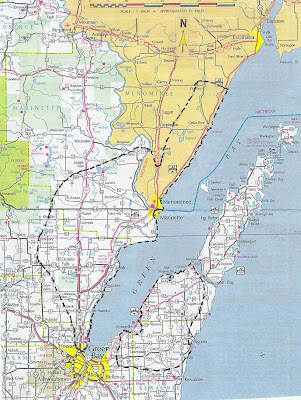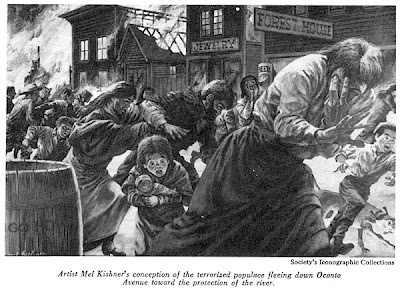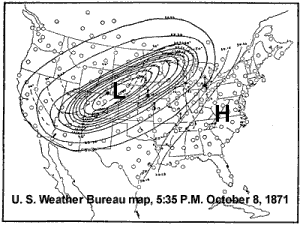But the same day the Chicago fire started, the Peshtigo fire, the most devastating wildfire in American history, burned across northeast Wisconsin, burning down 16 towns, killing between 1,200 and 2,400 people, and blackening 1.2 million acres. There are reports that it spotted 10 miles across Green Bay and only stopped when it reached Lake Michigan.

The fire began when railroad workers clearing land for tracks unintentionally started a vegetation fire. Before long, the fast-moving flames were whipping through the area 'like a tornado,' some survivors said. It was the small town of Peshtigo, Wisconsin that suffered the worst damage. Within an hour, the entire town had been destroyed.
The fire is named after the town because about 800 of those who died were in Peshtigo. The 1870 census listed the population at 1,700. More than 350 bodies were buried in a mass grave, primarily because so many had died that few remained alive who could identify them.
Survivors said the firestorm generated winds that threw rail cars and houses into the air. Many residents ran toward the nearby Peshtigo river, but some never made it. A little girl did, and held on to the horns of a cow in the river for hours. One man thought he had led his wife to the river through the smoke and flames, only to discover the woman was not his wife. According to reports, he later went crazy. Some made it to the river but then drowned.

The Peshtigo Fire Company had a single horse-drawn steam pumper to protect houses and the small factories near the river, but it was ineffective in the fire storm that wiped out the village. There was no other organized fire protection between the City of Green Bay and Marinette.
From U-S-History.com:
Conditions were ripe in the area that Fall, owing to an unusually dry summer. Small prairie fires were common and either burned themselves out or were quickly quenched. Loggers tried to hold their slash burning to small areas. Some farmers needed to burn small piles of brush that had accumulated from clearing land for additonal crop-growing acreage. And a railroad was being constructed at that time, between Michigan's Upper Peninsula and Milwaukee, Wisconsin. This necessarily left debris to the sides of the track.The U.S. military studied this perfect storm of conditions that devastated such a large area. Some of the lessons learned were used during World War II during fire-bombing campaigns of Japan and Germany.
A cold front moved across a broad expanse of northcentral America that day, which brought swirling winds that allowed small fires to combine into larger ones. Circumstances, such as this wind, the topography of the area, and the abundant fuel, all came together to create a perfect setting for a catastrophic event. As the temperature rose, so did the wind's intensity. A firestorm, in essence "nature's nuclear explosion," burst into being.
The firestorm, whipped by what is today acknowledged to have been a low-grade tornado, was described as "a wall of flame, a mile high, five miles wide, traveling 90 to 100 miles an hour, hotter than a crematorium, turning sand into glass." It destroyed 12 pioneer towns and about 1.5 million acres, or nearly 2,000 square miles, of prime timber, and killed an estimated 2,200 people.
Traveling in a northeasterly direction, the fire leapt the Peshtigo River (after the winds shifted to come out of the west) and burned a swath through the countryside before reaching the Bay of Green Bay, where it finally died out.





No comments:
Post a Comment